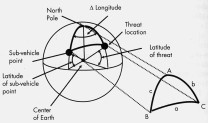
|
book reviews
Electronic warfare booksreviewed by T. Nelson |

|
book reviews
Electronic warfare booksreviewed by T. Nelson |

R. A. Poisel
Artech House, 2002, 544 pages
Reviewed by T. Nelson
Many of the high-tech civilian wireless communications technologies, such as frequency hopping, direct-sequence spread-spectrum (DSSS), and of course GPS, originated with the need for improved military communications. This long-awaited book is one of the few books available on the topic of electronic warfare as it pertains to communications systems instead of radar.
The first nine chapters, comprising the first half of the book, cover RF propagation and types of modulation, data encoding, data compression and encryption, receivers, and antennas. These basic concepts, which should already be thoroughly familiar to communications engineers, are described using relatively straightforward mathematics, presupposing only a familiarity with linear algebra and matrices.
The next three chapters, Signal Processing, Direction-Finding Position-Fixing Techniques, and Hyperbolic Position Fixing, are longer and take the subject into a deeper level of technical detail. Fourier, Hartley, Harr, and wavelet transforms and signal classifiers and their applications to signal intelligence gathering are clearly described, making extensive use of conditional probabilities and matrix algebra, and some calculus. The MUSIC method of superresolution direction finding, which determines eigenvectors to calculate the time difference of arrival of multiple signals, is described in detail. Chapter 15 discusses methods for detecting frequency-hopping signals, as would be needed to intercept a spread-spectrum signal.
One disappointment is the lack of information on communications jamming waveforms. Surely the military would not use Gaussian noise to interfere with enemy communications as the book suggests. Also, techniques for analyzing, discriminating, and classifying communication signals on the basis of their waveforms are not discussed. However, overall the book is an excellent introduction to wireless communication technology, and it provides in-depth information on some advanced topics with important military applications.
mar 16, 2002

by David L. Adamy
Artech House 2021, 232 pages
Reviewed by T. Nelson
Despite the title, this is not really a book on space electronic warfare, but an accessible introduction to satellite communications links. It starts out explaining spherical trigonometry, which differs from regular trigonometry in that the sides of a triangle are curved. This actually makes things easier because both the sides and angles of triangles are expressed in degrees, and Adamy explains it clearly.

The same formulas are used repeatedly in worked examples throughout the book. This means we see the picture at right fourteen times with slightly different labels.
The author has sections on radio propagation, effects of rain and fog, and link calculations. Line of sight loss to a satellite is on the order of 130 dB, while the minimum detectable signal of a receiver is only about −86 dBm when processing overhead is taken into account. But that's for isotropic emitters; when you add a 30 dBi antenna at each end, that brings the signal up by 60 decibels, so a satellite link can be pretty robust.
Satellite EW is either spoofing, interception, or jamming. To jam a satellite, you have to find it, be at the right wavelength, correct for Doppler, and transmit a strong enough noise to overcome 170 dB line of sight loss to be detected on the satellite antenna's sidelobe. And all that for a mere twelve minutes before it moves over the horizon. And you have to overcome direct sequence spread spectrum to do it. No wonder the US military is complacent.
Of course, adversaries can do other things besides set up satellite dishes.
Jamming ground communications from a satellite is even harder, as it may be 1500 times farther away than your transmitter. A satellite in geosynchronous orbit would be barely detectable, so you'd need a fleet of low earth orbit satellites to do it. Interestingly, because radar cross section figures in the jamming equation, the author says low RCS targets like stealth bombers are more susceptible to jamming than old-fashioned bombers.
This book won't get you in the door at JPL, but it will pound the basics of calculating satellite links into your head.
dec 23 2021